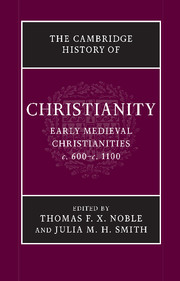Book contents
- Frontmatter
- Introduction: Christendom, c. 600
- Part I Foundations: Peoples, Places, and Traditions
- Part II Christianity in Confrontation
- Part III Christianity in the Social and Political Order
- Part IV Christianity as Lived Experience
- Part V Christianity: Books and Ideas
- 24 Visions of God
- 25 Orthodoxy and deviance
- 26 Making sense of the Bible
- 27 The Christian book in medieval Byzantium
- 28 Saints and their cults
- 29 Last Things
- Conclusion: Christendom, c. 1100
- Bibliographies
- Index
- References
27 - The Christian book in medieval Byzantium
from Part V - Christianity: Books and Ideas
Published online by Cambridge University Press: 28 March 2010
- Frontmatter
- Introduction: Christendom, c. 600
- Part I Foundations: Peoples, Places, and Traditions
- Part II Christianity in Confrontation
- Part III Christianity in the Social and Political Order
- Part IV Christianity as Lived Experience
- Part V Christianity: Books and Ideas
- 24 Visions of God
- 25 Orthodoxy and deviance
- 26 Making sense of the Bible
- 27 The Christian book in medieval Byzantium
- 28 Saints and their cults
- 29 Last Things
- Conclusion: Christendom, c. 1100
- Bibliographies
- Index
- References
Summary
Of all the artisanal productions preserved from the time since Constantine I (the Great) began calling Byzantium, the capital of the old eastern Roman empire, by a new name (Constantinople – Constantine’s polis, or city), probably the most familiar today are icons and buildings such as Hagia Sophia. But it is arguable that Byzantine books should share pride of place.
Across the imperial centuries, Greek manuscripts – usually deluxe copies of the Gospels or service books, but also theological treatises such as the copy of Dionysius the Areopagite sent to Louis the Pious in 827 – served as valuable diplomatic gifts. After the fall of Constantinople to the Ottoman Turks in 1453 they were collected by humanist scholars, particularly, though not exclusively, for the ancient Greek authors whose texts they preserved; and by the French kings who saw themselves as the successors to the Byzantine emperors and surrounded themselves with the trappings of their purported ancestors. Beyond the role of Greek manuscripts in cultural history, their contents – and decoration – are important as testimony to the ways medieval Byzantines ordered and arranged their thoughts, and for the ways that images were used to reinforce and shape the world of the largely urban elite who had access to, and could actively read, books.
- Type
- Chapter
- Information
- The Cambridge History of Christianity , pp. 554 - 580Publisher: Cambridge University PressPrint publication year: 2008



